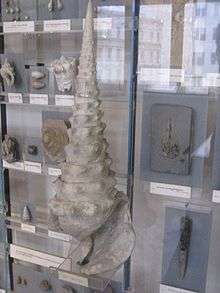Campanile (gastropod)
Campanile is a genus of large sea snails, marine gastropod molluscs in the family Campanilidae.
| Campanile | |
|---|---|
 | |
| Shell of the fossil species Campanile giganteum | |
| Scientific classification | |
| Kingdom: | |
| Phylum: | |
| Class: | |
| (unranked): | clade Caenogastropoda |
| Superfamily: | |
| Family: | |
| Genus: | Campanile |
| Synonyms | |
| |
Biology
All species in this genus have become extinct, except Campanile symbolicum Iredale, 1917 from southwestern Australia. They used to flourish in the Tethys Sea and underwent a widespread adaptive radiation in the Cenozoic.[2]
Species
Species within the genus Campanile include:
- † Campanile auvertianum
- † Campanile brookmani Cox 1930
- † Campanile claytonense
- † Campanile cornucopiae
- † Campanile dilloni
- † Campanile elongatum
- † Campanile giganteum (Lamarck, 1804) - a gigantic fossil species from the Eocene
- † Campanile gigas Martin 1881
- † Campanile greenellum
- † Campanile hebertianum
- † Campanile houbricki[3]
- † Campanile parisiense
- † Campanile paratum
- Campanile symbolicum Iredale, 1917 - a living Australian species. This is the only extant species of Campanilidae.[4]
- † Campanile tchihatcheffi d’Archiac 1850
- † Campanile trevorjacksoni Portell & Donovan, 2008 - a fossil species from the Eocene[5][6]
- † Campanile uniplicatum (d'Orbigny, 1850)
- † Campanile villaltai
gollark: I'm just fixing BUG™.]
gollark: Okay, I finished making it extract answers and vote count, now it just needs to extract code.
gollark: ... right, HTML parser time...
gollark: Never mind, my IDE has an automatic HTML reindenter.
gollark: Given that their HTML is also terribly formatted I'm considering just using an actual HTML parser.
References
- Fischer P. (1884). Manuel de Conchyliologie et de Paleontologie Conchyliologique. F. Savy, Paris. 609-688. page 680.
- Richard S. Houbrick, Anatomy, Biology and Systematics of Campanile symbolicum with reference to adaptive radiation of the Cerithiacea (Gastropoda, Prosobranchia); Malacologia 1981 31 (1-2): 263-289
- Kiel S., Bandel K., Banjac N. & Perrilliat M. C. (2000). "On Cretaceous Campanilidae (Caenogastropoda, Mollusca)". Freiberger Forschungshefte ser. C, 490(8): 67-132. page 89. abstract
- (in Czech) de Bruyne R. H. (2004). Encyklopedie ulit a lastur. Rebo Productions, 336 pp., ISBN 80-7234-288-6, page 82.
- Portell R. W. & Donovan S. K. (2008). "Campanile trevorjacksoni sp. nov. (Mollusca: Gastropoda) from the Eocene of Jamaica: at last, a name for the first fossil used in intercontinental biostratigraphic correlation (de la Beche 1827)". Geological Journal 43(5): 542-551. doi:10.1002/gj.1128.
- Mitchell F. S. (2009). "Discussion of Campanile trevorjacksoni sp. nov. (Mollusca: Gastropoda) from the Eocene of Jamaica—at last, a name for the first fossil used in intercontinental biostratigraphic correlation (de la Beche 1827): (v. 43, p. 542–551)". Geological Journal 44(4): 494-496. doi:10.1002/gj.1155.
- Fossilworks: Campanile
- M. Harzhauser. 2007. Oligocene and Aquitanian gastropod faunas from the Sultanate of Oman and their biogeographic implications for the western Indo-Pacific. Palaeontographica Abteilung A 280:75-121
This article is issued from Wikipedia. The text is licensed under Creative Commons - Attribution - Sharealike. Additional terms may apply for the media files.